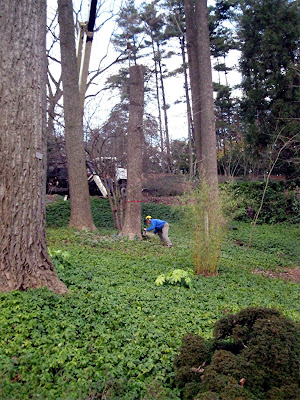Warm weather continues though a bit cooler than the beginning of the week. Because the sun was out, 51F felt pretty good. In the morning I did inventory and mapped plants on Korean Hill with Joe Menes. We're combining inventory with mapping because many of the plants on Korean Hill haven't been mapped with our newest, accurate to 21", GPS. The unit was, for the most part cooperative (satellites will be satellites) so we made good progress. Joe did most of the work. In the afternoon, the two of us along with Carole, walked the collection to review points along a walking tour, that will also be a virtual tour, or vice versa. We decided that the collection is beautiful and that there is no simple route to see everything. I think we're going in the right direction though.
This camellia is flowering outside the entrance to the ladies room at the Asian Collections parking lot. It's only one of many spring flowering varieties out now. This one is actually suggested for USDA Zone 8 because it wants to flower in the middle of winter. According to our new Zone map we're in 7b. This winter it's more like 8b.
This camellia is flowering outside the entrance to the ladies room at the Asian Collections parking lot. It's only one of many spring flowering varieties out now. This one is actually suggested for USDA Zone 8 because it wants to flower in the middle of winter. According to our new Zone map we're in 7b. This winter it's more like 8b.










